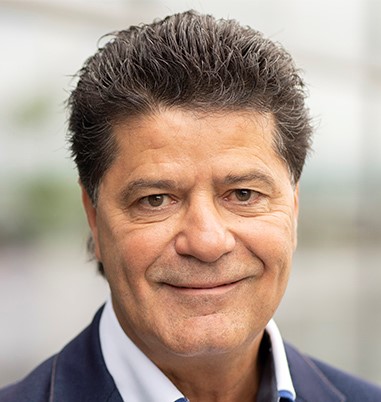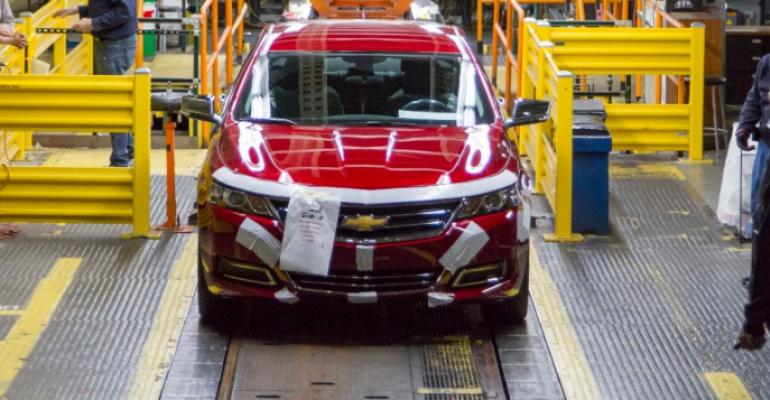The changes sweeping through the automotive industry pose a challenge not only for companies with long histories and huge investments in established technology but also unions worrying globally that many jobs could disappear as battery-electric vehicles dominate sales, UAW President Rory Gamble says.
Union responses range from demands for new investment in unionized plants to negotiating special agreements with automakers.
Gamble (below, left) says the UAW pressed for the modernization of the General Motors Detroit-Hamtramck Assembly Plant, now called Factory Zero, where the new all-electric GMC Hummer SUV will be built. “UAW members have never shied away from working with new technology,” he says in a conference call.
In line with Chairman Mary Barra’s stated goal of the automaker becoming carbon neutral by 2040, GM says it will continue to increase the fuel efficiency of its traditional internal-combustion vehicles in accordance with fuel-economy and greenhouse-gas regulations.
Some of these initiatives include technologies such as stop/start, aerodynamic enhancements, downsized boosted engines, more efficient transmissions and other vehicle improvements, including mass reduction and lower rolling resistance tires, according to GM.
A 2018 UAW study on trends in automotive technology, however, finds the burden of transition could fall most heavily on workers employed in traditional powertrain plants that make castings and build engines and transmissions.
GM operates 10 engine, transmission and casting plants in Michigan, Ohio, Indiana, Tennessee and New York. The plants employ about 7,000 of the automaker’s 49,000 blue-collar workers, according to GM.
GM’s construction of a new battery plant in Lordstown, OH, reflects its push for electrification, which will produce some 30 new models by the middle of the decade. The automaker also is pursuing a strategy of vertical integration of key EV components, according to GM President Mark Reuss.
 The shift toward vertical integration, defined as ownership of the supply chain, is a departure from the outsourcing strategy GM has used since the 1980s and was disliked by the UAW and its members.
The shift toward vertical integration, defined as ownership of the supply chain, is a departure from the outsourcing strategy GM has used since the 1980s and was disliked by the UAW and its members.
Gamble says the UAW is counting on help from President Joe Biden, who is pushing for the faster adoption of EVs to help fight climate change.
“The UAW has been working closely with President Biden’s transition team, and now the administration, on policies regarding the long-term development of electric vehicles in the marketplace,” the UAW president says.
Gamble says even with the new product goals, it will be some time before the transition occurs. “But the important thing is that President Biden agrees with our position that any new jobs replacing (combustion) engines are union-wage and -benefit jobs that are created right here in the U.S. And we believe the Detroit Three will locate these new products right here in the U.S,” he says.
Unifor, the union representing GM, Ford and Stellantis workers in Canada, is demanding that all three companies build electrified vehicles with support from the provincial government in Ontario and the Canadian federal government.
Unifor’s effort to guarantee jobs as the industry’s technology shifts includes direct negotiations with the automakers as well as gaining support from Canadian political figures, according to union President Jerry Dias (below).
 Meanwhile, in Europe, unions also have gone to the bargaining table to protect members’ interests.
Meanwhile, in Europe, unions also have gone to the bargaining table to protect members’ interests.
For example, the voice of employees is being heard at Daimler, which is preparing for a fundamental corporate reorganization that will divide the German company into separate companies for light vehicles and heavy trucks to speed the adoption of new technology.
Michael Brecht, chairman of Daimler’s General Works Council, and the top employee representative on the company’s Supervisory Board, says he favors the plan. Brecht also is an official of the IG Metall union.
“The transformation of our industry is moving ahead quickly. In order for us to keep pace, we need to invest in innovations boldly and more quickly,” he says.
The split will provide additional support for each facility and help secure employment, Brecht notes. In addition, existing labor agreements are unaffected, remaining in force until the end of the decade.





